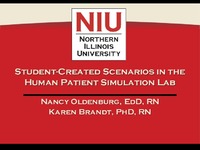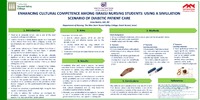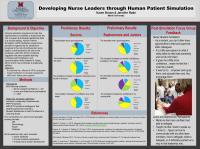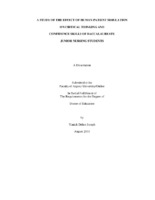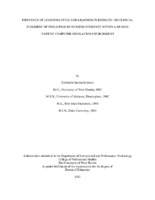| dc.contributor.author | Oldenburg, Nancy | en |
| dc.contributor.author | Brandt, Karen | en |
| dc.date.accessioned | 2012-01-11T11:05:43Z | |
| dc.date.available | 2012-01-11T11:05:43Z | |
| dc.date.issued | 2012-01-04 | |
| dc.identifier.uri | http://hdl.handle.net/10755/202020 | |
| dc.description | <p>41st Biennial Convention - 29 October-2 November 2011. Theme: People and Knowledge: Connecting for Global Health. Held at the Gaylord Texan Resort & convention Center.</p> | en |
| dc.description.abstract | <p>In recent years, there has been a great deal of interest in the use of human patient simulation (HPS) in nursing education. This presentation describes one novel approach for the use of this strategy, a project that involved the development of student-created scenarios in a baccalaureate nursing program. Over two semesters, small groups of students designed, developed, and implemented scenarios involving pediatric patient situations in the HPS laboratory. Students in the course were assigned to groups of six to eight students. Each group was given a pediatric-focused condition to research. The conditions were designed to complement classroom and clinical learning through the integration of situations that were unlikely to be experienced by students in the clinical setting or through supplementation of content covered in the classroom. The project was divided into phases. The first phase involved the researching of the assigned condition, including clinical manifestations and management (nursing and medical). In the second phase, students developed a draft of the scenario, including the identification of learning objectives and details such as scenario "actors" (patient, parent or significant other, healthcare providers) and scenario progression. At the conclusion of the project, students from each group implemented their scenarios in the HPS laboratory, with students from another group acting as participants. This project gave students the opportunity to interact with essential pediatric content in a unique way, as well as to have expanded pediatric clinical experiences in a safe, controlled environment. Qualitative data (in the form of student reflective papers) were collected and analyzed related to the challenges and benefits of this learning strategy. These data, as well as the perceptions of the faculty involved, will be presented.</p> | en |
| dc.description.sponsorship | Sigma Foundation for Nursing | en |
| dc.format | Text-based Document | en |
| dc.language.iso | en_US | en |
| dc.subject | Human Patient Simulation | en |
| dc.subject | Nursing Education | en |
| dc.title | Student-created scenarios in the human patient simulation lab | en |
| dc.type | Presentation | en |
| dc.rights.holder | <p>
All rights reserved by the author(s) and/or publisher(s) listed in this item record unless relinquished in whole or part by a rights notation or a Creative Commons License present in this item record.
</p><p>
All permission requests should be directed accordingly and not to the Sigma Repository.
</p><p>
All submitting authors or publishers have affirmed that when using material in their work where they do not own copyright, they have obtained permission of the copyright holder prior to submission and the rights holder has been acknowledged as necessary.
</p> | en |
| dc.description.note | <p>Items submitted to a conference/event were evaluated/peer-reviewed at the time of abstract submission to the event. No other peer-review was provided prior to submission to the Henderson Repository, unless otherwise noted.</p> | |
| dc.type.category | Full-text | en |
| dc.evidence.level | N/A | en |
| dc.research.approach | N/A | en |
| dc.author.details | Nancy Oldenburg, EdD, RN; Karen Brandt PhD, RN | en |
| dc.conference.name | 41st Biennial Convention: People and Knowledge: Connecting for Global Health | en |
| dc.conference.host | Sigma Theta Tau International | en |
| dc.conference.location | Grapevine, Texas, USA | en |
| dc.date.conferenceyear | 2011 | |
| dc.description.reviewtype | Abstract Review Only: Reviewed by Event Host | en |
| dc.description.acquisition | Proxy-submission | en |
